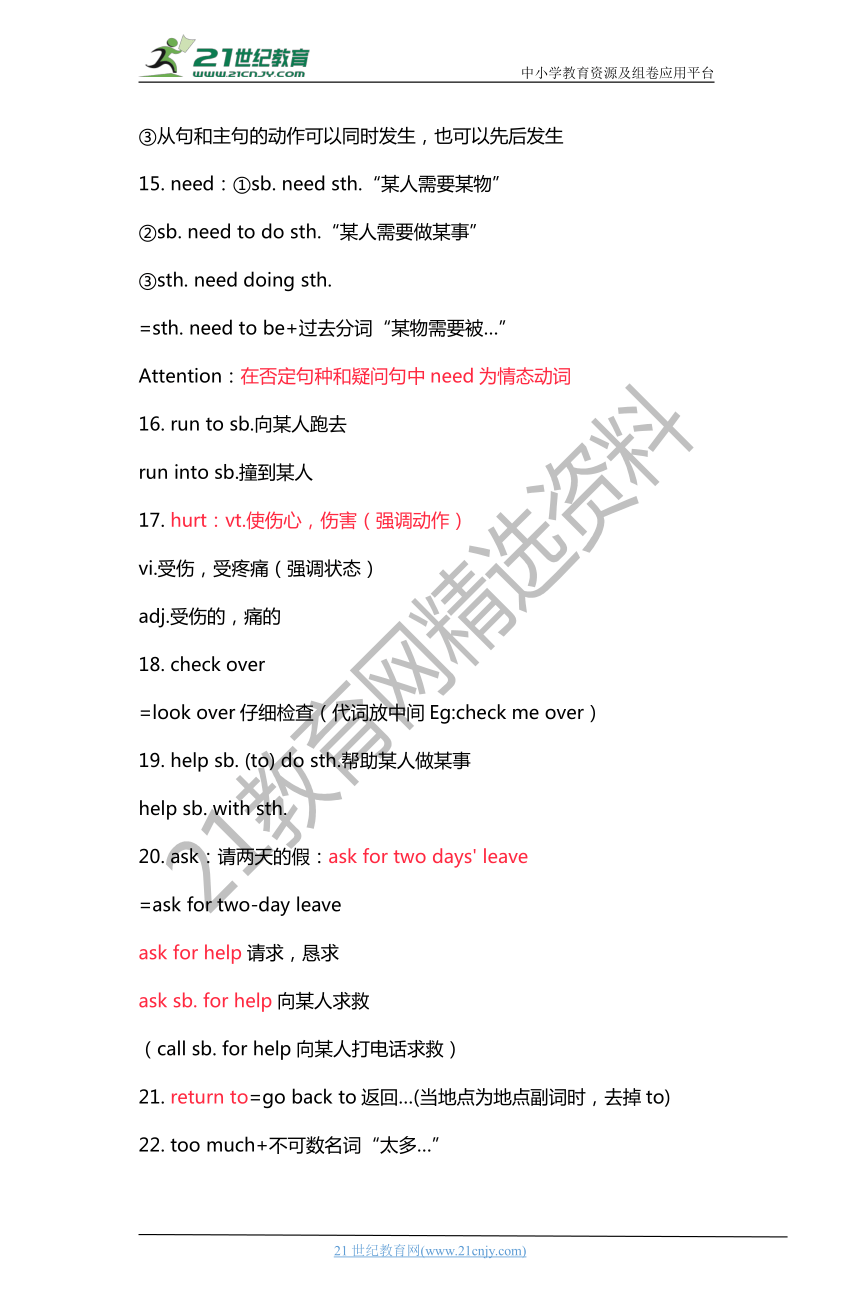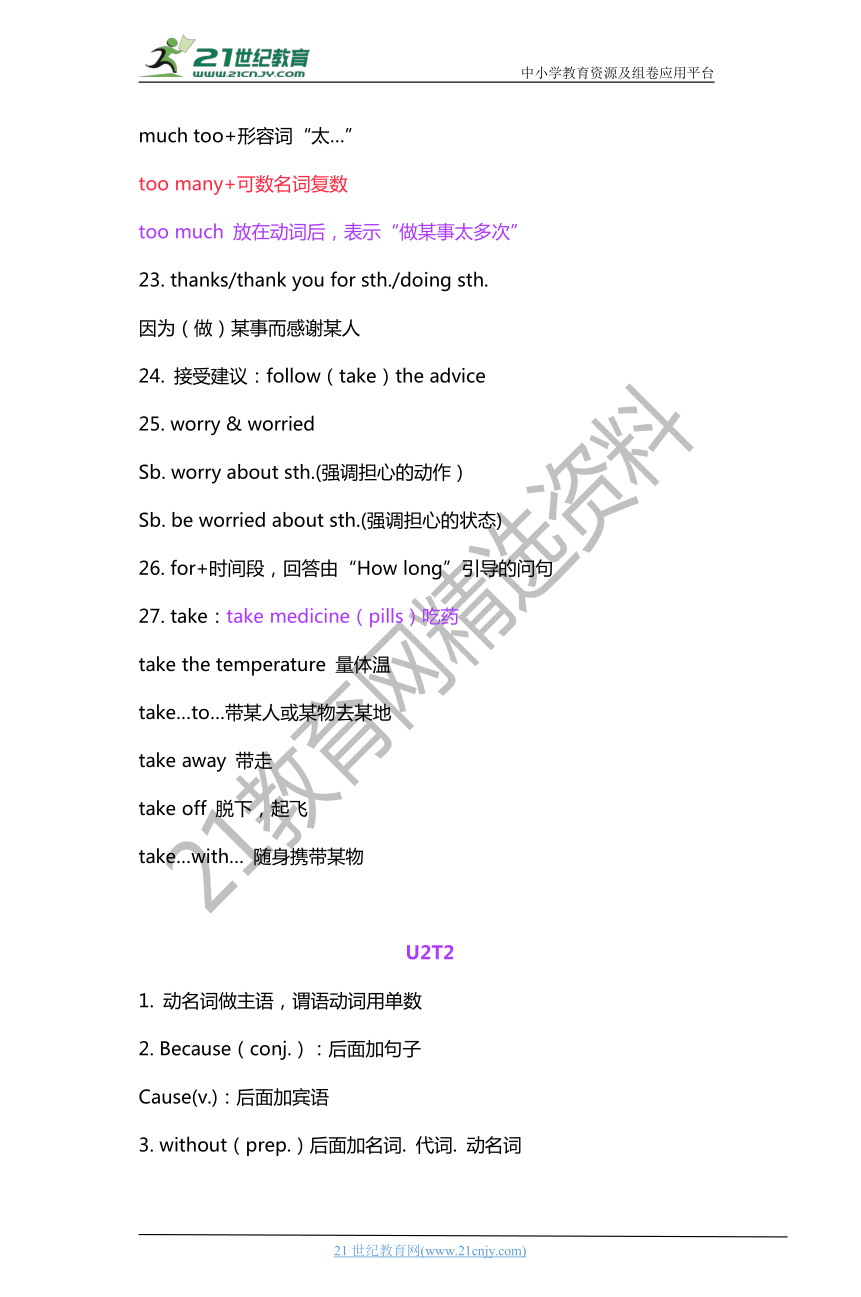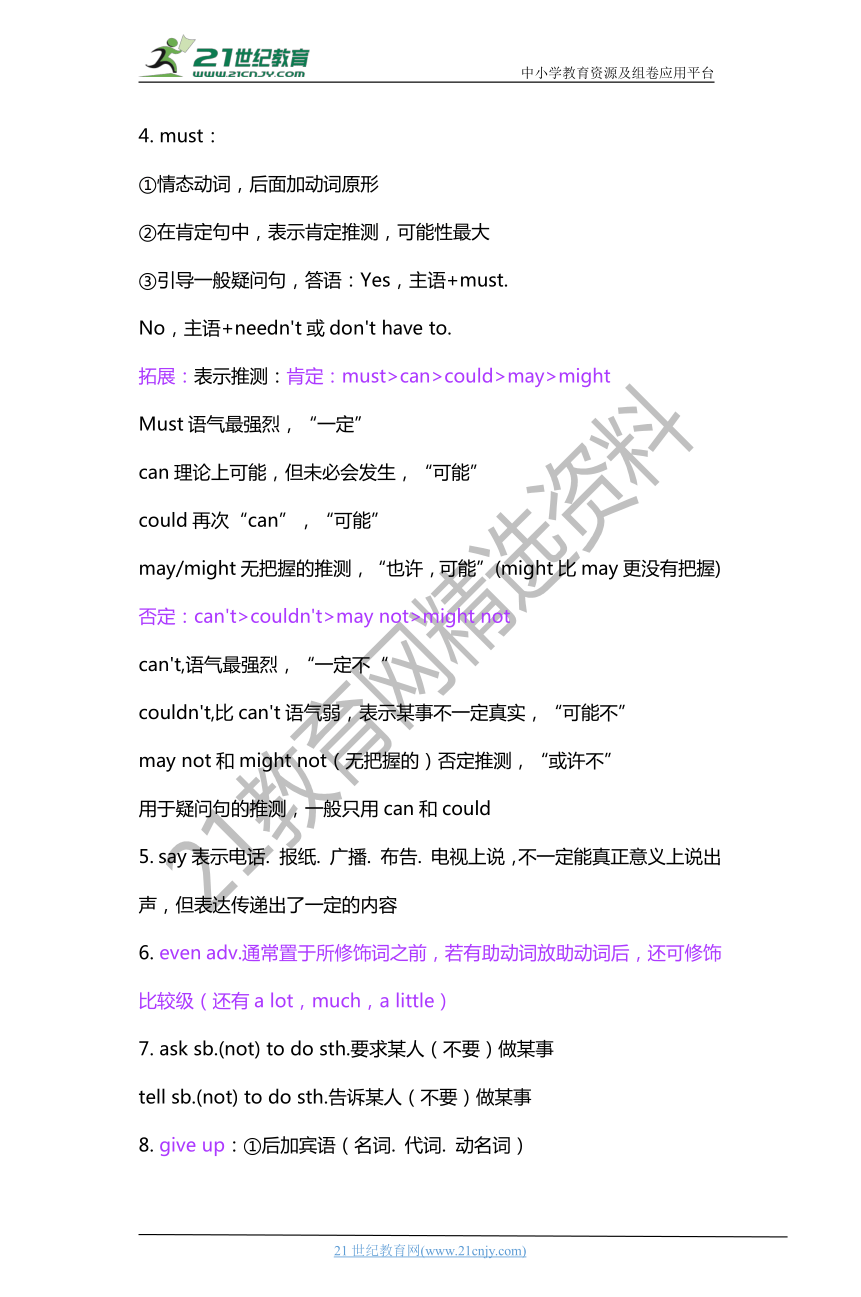Unit 2 Keeping Healthy 知识点汇总
文档属性
| 名称 | Unit 2 Keeping Healthy 知识点汇总 |  | |
| 格式 | zip | ||
| 文件大小 | 1.2MB | ||
| 资源类型 | 试卷 | ||
| 版本资源 | 仁爱科普版 | ||
| 科目 | 英语 | ||
| 更新时间 | 2020-07-01 18:24:06 | ||
图片预览





文档简介
中小学教育资源及组卷应用平台
八上Unit2知识点
U2T1
1.
well:
①adj.表示身体好的,健康的
②adv.好地
2.
What's
wrong
with
sb.?
=What
happened
to
sb.?某人怎么了?
3.
have
a
headache/toothache/backache/stomachache/fever
头疼/牙疼/背疼/胃疼/发烧
have
the
flu
患流感
严重的病可用terrible或bad来修饰
4.
I'm
sorry+动词不定式,或I'm
sorry
+that
从句表示对所做错事的一种歉意或听到不好消息时的委婉表达21世纪教育网版权所有
5.
should,情态动词,常用来建议或告诫别人该做什么不该做什么,后面加动词原形
(否定形式:shouldn't)
6.
had
better
do
sth.最好做某事
had
better
not
do
sth.最好不要做某事
7.
现在完成时句子基本构成:have/has+动词的过去分词(have和has是助动词,无意义)
8.
take
sb.
to
sp.带某人去某地
9.
have
a
rest
=take
a
rest休息一下
10.?suggest
=advise建议(v.)
suggest
sb.(not)?to
do
sth.
advise
sb.?(not)?to
do
sth.
建议某人(不要)去做某事
suggestion(可数)=advice(不可数)建议(n.)
一条建议
a
piece
of
advice
两条建议
two
pieces
of
advice
11.
take
pills(pill,可数,专指药丸)
take
medicine(medicine,不可数,泛指药)
Attention:吃药不能用have和eat
12.
feel
like(介词)
doing
sth.
=want
to
do
sth.
=would
like
to
do
sth.想要做某事
13.?nothing,something,anything等不定代词碑形容词修饰时,形容词放其后
14.
while
&
when(引导时间状语从句)当……时候
While:①动词必须是延续性动词
②从句和主句的动作同时发生,两句都用过去进行时??
③强调主句的动作在从句的动作发生过程中
When:①动词可以是短暂性动词,也可以是延续性动词
②主句用过去进行时,从句一般用一般过去时
③从句和主句的动作可以同时发生,也可以先后发生
15.
need:①sb.
need
sth.“某人需要某物”
②sb.
need
to
do
sth.“某人需要做某事”
③sth.
need
doing
sth.
=sth.
need
to
be+过去分词“某物需要被…”
Attention:在否定句种和疑问句中need为情态动词
16.
run
to
sb.向某人跑去
run
into
sb.撞到某人
17.?hurt:vt.使伤心,伤害(强调动作)
vi.受伤,受疼痛(强调状态)
adj.受伤的,痛的
18.
check
over
=look
over仔细检查(代词放中间Eg:check
me
over)
19.
help
sb.
(to)
do
sth.帮助某人做某事
help
sb.
with
sth.
20.
ask:请两天的假:ask
for
two
days'
leave
=ask
for
two-day
leave
ask
for
help请求,恳求
ask
sb.
for
help向某人求救
(call
sb.
for
help向某人打电话求救)
21.?return
to=go
back
to返回…(当地点为地点副词时,去掉to)
22.
too
much+不可数名词“太多…”
much
too+形容词“太…”
too
many+可数名词复数
too
much
放在动词后,表示“做某事太多次”
23.
thanks/thank
you
for
sth./doing
sth.
因为(做)某事而感谢某人
24.
接受建议:follow(take)the
advice
25.
worry
&
worried
Sb.
worry
about
sth.(强调担心的动作)
Sb.
be
worried
about
sth.(强调担心的状态)
26.
for+时间段,回答由“How
long”引导的问句
27.
take:take
medicine(pills)吃药
take
the
temperature
量体温
take…to…带某人或某物去某地
take
away
带走
take
off
脱下,起飞
take…with…
随身携带某物
U2T2
1.
动名词做主语,谓语动词用单数
2.
Because(conj.):后面加句子
Cause(v.):后面加宾语
3.
without(prep.)后面加名词.
代词.
动名词
4.
must:
①情态动词,后面加动词原形
②在肯定句中,表示肯定推测,可能性最大
③引导一般疑问句,答语:Yes,主语+must.
No,主语+needn't或don't
have
to.
拓展:表示推测:肯定:must>can>could>may>might
Must语气最强烈,“一定”
can理论上可能,但未必会发生,“可能”
could再次“can”,“可能”
may/might无把握的推测,“也许,可能”(might比may更没有把握)
否定:can't>couldn't>may
not>might
not
can't,语气最强烈,“一定不“
couldn't,比can't语气弱,表示某事不一定真实,“可能不”
may
not和might
not(无把握的)否定推测,“或许不”
用于疑问句的推测,一般只用can和could
5.
say表示电话.
报纸.
广播.
布告.
电视上说,不一定能真正意义上说出声,但表达传递出了一定的内容21cnjy.com
6.?even
adv.通常置于所修饰词之前,若有助动词放助动词后,还可修饰比较级(还有a
lot,much,a
little)21·cn·jy·com
7.
ask
sb.(not)
to
do
sth.要求某人(不要)做某事
tell
sb.(not)
to
do
sth.告诉某人(不要)做某事
8.?give
up:①后加宾语(名词.
代词.
动名词)
②加代词作宾语,宾语放中间(give
it
up)
9.?enough:①adj.
“充分的,足够的”,加名词??
②adv.“充分地,足够地”,修饰形容词和副词,放其后
③n.
“足够”
10.
主过从过:主句用过去时,宾语从句也用过去时
Eg:
She
said
it
might
cause
illness.
主将从现:主句用将来时,状语从句用一般现在时表将来
Eg:
If
it
doesn't
rain
tomorrow,
I
will
play
soccer.
as
soon
as
“…就马上…”引导时间状语从句,此句型“主将从现”
Eg:
I
will
call
you
as
soon
as
I
get
to
Beijing.
11.
照顾好某人:①care
for
sb.
very
well.
②look
after
sb.
very
well.
③take
good
care
of
sb.
12.
强迫某人(不要)做某事Force
sb.
(not)
to
do
sth.
13.
感官动词:taste
sound
feel
look
smell
尝起来,听起来,感觉起来,看起来,闻起来
(感官动词后面加形容词)??
14.
could
&
may
could:①can的过去式
?②在疑问句中表示委婉请求
may:①表推测,可能,用于肯定句中
②表请求.
许可,意为“可以”,可和“can”互换(表请求时用于第一人称的一般疑问句时,否定回答用mustn't或can't)?
?
?
③表祝愿
15.
do
harm
to
sb.对某人有害
16.?not
only…but(a
(?http:?/??/?www.21cnjy.com?)lso)…不仅…而且…,并列两个对等的句子成分。并列两个主语时,谓语动词与后一个保持一致,即“就近原则”
17.
risk
doing
sth.冒风险做某事
18.?over=more
than多于……
U2T3
1.?talk
to
sb.强调一方向另一方说话
talk
with
sb.强调双方谈话
talk
with/to
sb.
about
sth.
和某人谈论(讨论)某事
2.?keep
away
from…
=stay
away
from…
=get
away
from…“远离……”
3.?question
&
problem
question:[C](容易解决.
口头回答的问题,与ask和answer搭配)
problem:[C](抽象问题Eg:心理问题,社会问题……,与solve搭配)
4.?go
ahead
and
do
sth.赶快做某事
5.
“to
do…”为不定式短语,为目的状语,“为了…”
6.?must
&
have
to
Must
强调说话者的主观看法(无人称.
数和时态时的变化)
Have
to
强调客观的需要(有人称.
数和时态的变化)
7.
open(v.)打开?
反义词
close(v.)关闭【强调动作】
open(adj.)打开着的?
反义词
closed(adj.)关闭着的【强调状态】?
8.afraid:
①I
am
afraid(that)…(口语常用结构。表示遗憾地)认为…恐怕…
②be
afraid
of
sth,/
be
afraid
of
doing
sth./
be
afraid
that…
担心某事/担心做某事/害怕…
③be
afraid
to
do
sth.(害怕其结果而)不敢做…
9.
给某人打电话:call
sb.
up
=give
sb.
a
call(人称代词放中间)
10.?right
now
=right
away
=at
once
马上
11.
留口信
leave
a
message?
捎口信give
a/the
message
传口信
take
a
message
给某人捎口信?give
a
message
to
sb.
=take
a
message
for
sb.
12.
sth.
happens
to
sb./sth.?
某人/某物发生某事
happen
to
do
sth.碰巧做某事
13.?try
to
do
sth.设法/尽力/试图做某事
try
one's
best
to
do
sth.尽某人最大努力做某事
try
one's
best
=do
one's
best某人尽自己最大的努力
14.
stay:
stay+adj.“保持某种状态”,相当于“keep+adj.”
15.?say
no
to?“拒绝.
远离”,后面加名词.
代词.
动名词
类似的结构:say
thanks/goodbye/hello/sorry
to
16.?give
a
talk
to
sb.给某人一个讲话
give
a
talk
about
sth.一个关于某事的讲话
give
a
talk
about
sth.
to
sb.给某人一个关于某事的讲话
17.?stop
to
do
sth.停下来去做某事
stop
doing
sth.停下来正在做的事
18.?get
sb./sth.
doing
sth.(使某人/物一直怎么样…进行中)
19.
instead
of+名词/代词/动名词“代替,而不是”介词短语
instead是副词,只能单独使用
20.
until“一直到…”,多用于肯定句,主句动词多为延续性动词
not…until…“直到…才…”,主句动词多为短暂性动词
Unit2
topic
1
1.
well
的用法
(1)look
well
look在这里译作“看起来”,作连系动词,后接形容词。
(2)sleep
well
well
通常来说是副词,但是当表示身体好坏时,是形容词。
2.
What’s
wrong
with
you?
=What’s
the
matter/trouble
with
you?
3.?suggest/advise
suggest
doing
advise
to
do
suggestion
可数名词advice不可数名词advise动词
4.
enough?
修饰名词
enough+名词
修饰形容词/副词
形容词/副词
+enough+名词“形前名后”
5.
表建议或劝告?
had
better
(not)
do
sth.最好(不)做某事
should
(not)
do
sth.
(不)应该做某事?
6.
medicine/pil
take
medicine吃/服药(片)medicine不可数
have/take
pills
吃/服药(片)pill可数
7.?too
much
+
不可数名词,表
“太多……”
too
many+可数名词复数
much
too
+
形容词,表
“太……”
candy为不可数名词,做糖的种类时就可数了。
8.
想要做某事
feel
like
doing
sth.
would
like
to
do
sth
9.
lie的用法
lie
躺
lay
(过去式)
lie
撒谎
lied
lay
下蛋
laid
10.?help
sb.
with
sth.帮助某人某事
help
with
sth.
帮助某事
help
sb.
(to)
do
sth.帮助某人做某事
with
the
help
of?
=
with
one’s
help
在……的帮助下
ask
sb.
for
help?
=
turn
to
sb.向某人寻求帮助
11.
leave
(1)
leave作为n.
时,意为“休假”
请两周假
ask
for
two
weeks’
leave?
=
ask
for
a
two-week
leave请假
(2)
leave作为v.
时,意为“离开;留下”。leave
for动身去某地
leave
a
message留言
take
a
message捎口信?
=
give
sb.
a
message
Topic2
I
must
ask
him
to
give
up
smoking.
1.
worry用法.?v.?
worry
about担心……?
e.g.
Don’t
worry
about
me.
I
am
fine.?
adj.
worried
担心的,?
be
worried
about
担心……?
e.g.
He
was
worried
about
the
test.?
2.
watch主要用于观看电视节目、球赛、游戏和话剧,强调动作
see
与watch都可以用于观看比赛、电视节目、演出、电影等,但see强调结果
read主要用于读书、看报
look强调动作,不及物动词常与at搭配使用
3.
staying
up
late
(be)
bad
for
your
health.?
此处动名词短语在句中作主语,谓语动词用单数。
4.
put
into
把……丢进……
put
away
收拾
put
up
粘贴,悬挂;举起
put
on
穿上,上映
put
off
推迟
5.?give
up
+
doing
sth.
放弃做某事
give
up
sth.
放弃某东西
give
up
接人称代词时放在两词中间
I
don’t
like
history,
so
I
want
to
give
it
up.
6.
It’s
necessary
for
sth.对……来说是很有必要的
It’s
+
necessary
+
(for
sb.)
to
do
sth.(对某人来说)做某事有必要
It’s
+
adj.
+
(for
sb.)
to
do
sth.(对某人来说)做某事是怎么样的……
7.
Be
careful
not
to
eat
too
much
salt
or
sugar.
否定句中常用or代替and表示和的意思
【拓展】意为“否则,不然”,用于警告或忠告
8.
as
soon
as
意为“一……就”
可用(主将从现)
We
will
go
back
to
school
as
soon
as
the
summer
holiday
is
over.
9.
But
his
mother
made
him
taste
it.
make
sb./sth.
+adj?使某人/某物怎么样?
make
sb./sth.
+
do
sth.使某人/某物做某事
10.
suprise用法
【拓展】surprise
动词,意为“使吃惊”
be
surprised
to
do
sth.?
be
surprised
at
sth.?
?surprise
名词,意为“惊讶”
11.
such
as/for
example
Lunch:?rice
with
a
lot
of
meat
such
as
chicken.
beef,
etc.
such
as后接名词或短语He
kn
(?http:?/??/?www.21cnjy.com?)ows
many
languages
such
as
Chinese,English,Russian
and
French.?21教育网
for
example
后接句
(?http:?/??/?www.21cnjy.com?)子He
is
a
good
boy
for
example
he
often
helps
his
mother
with
the
housework.www.21-cn-jy.com
Topic3
Must
we
exercise
to
prevent
the
flu?
12.
as...as
possible
尽可能……
尽可能快
as
soon
as
possible
尽可能早
as
early
as
possible
13.?prevent
sb.
(from)
doing
sth.
阻止某人做某事,此处from可省略。
stop/keep
sb.
from
doing
sth.
阻止某人做某事,此处from不可省略。
14.
afraid形容词,害怕的,担心的,恐怕
害怕做某事
be
afraid
to
do
sth.
be
afraid
of
doing
sth.
15.
让:
make/get
make/get
sb/sth
doing
sth“让某人/某物一直做"
get
sb
to
do
sth
“使某人做某事”
get
+
adj.“……变得……”
16.instead
of?是介词短语,后接名词、代词和动名词,放在句中句首都可以
take
the
place
of?是动词词组,作谓语,放在句中
21世纪教育网
www.21cnjy.com
精品试卷·第
2
页
(共
2
页)
HYPERLINK
"http://www.21cnjy.com/"
21世纪教育网(www.21cnjy.com)
八上Unit2知识点
U2T1
1.
well:
①adj.表示身体好的,健康的
②adv.好地
2.
What's
wrong
with
sb.?
=What
happened
to
sb.?某人怎么了?
3.
have
a
headache/toothache/backache/stomachache/fever
头疼/牙疼/背疼/胃疼/发烧
have
the
flu
患流感
严重的病可用terrible或bad来修饰
4.
I'm
sorry+动词不定式,或I'm
sorry
+that
从句表示对所做错事的一种歉意或听到不好消息时的委婉表达21世纪教育网版权所有
5.
should,情态动词,常用来建议或告诫别人该做什么不该做什么,后面加动词原形
(否定形式:shouldn't)
6.
had
better
do
sth.最好做某事
had
better
not
do
sth.最好不要做某事
7.
现在完成时句子基本构成:have/has+动词的过去分词(have和has是助动词,无意义)
8.
take
sb.
to
sp.带某人去某地
9.
have
a
rest
=take
a
rest休息一下
10.?suggest
=advise建议(v.)
suggest
sb.(not)?to
do
sth.
advise
sb.?(not)?to
do
sth.
建议某人(不要)去做某事
suggestion(可数)=advice(不可数)建议(n.)
一条建议
a
piece
of
advice
两条建议
two
pieces
of
advice
11.
take
pills(pill,可数,专指药丸)
take
medicine(medicine,不可数,泛指药)
Attention:吃药不能用have和eat
12.
feel
like(介词)
doing
sth.
=want
to
do
sth.
=would
like
to
do
sth.想要做某事
13.?nothing,something,anything等不定代词碑形容词修饰时,形容词放其后
14.
while
&
when(引导时间状语从句)当……时候
While:①动词必须是延续性动词
②从句和主句的动作同时发生,两句都用过去进行时??
③强调主句的动作在从句的动作发生过程中
When:①动词可以是短暂性动词,也可以是延续性动词
②主句用过去进行时,从句一般用一般过去时
③从句和主句的动作可以同时发生,也可以先后发生
15.
need:①sb.
need
sth.“某人需要某物”
②sb.
need
to
do
sth.“某人需要做某事”
③sth.
need
doing
sth.
=sth.
need
to
be+过去分词“某物需要被…”
Attention:在否定句种和疑问句中need为情态动词
16.
run
to
sb.向某人跑去
run
into
sb.撞到某人
17.?hurt:vt.使伤心,伤害(强调动作)
vi.受伤,受疼痛(强调状态)
adj.受伤的,痛的
18.
check
over
=look
over仔细检查(代词放中间Eg:check
me
over)
19.
help
sb.
(to)
do
sth.帮助某人做某事
help
sb.
with
sth.
20.
ask:请两天的假:ask
for
two
days'
leave
=ask
for
two-day
leave
ask
for
help请求,恳求
ask
sb.
for
help向某人求救
(call
sb.
for
help向某人打电话求救)
21.?return
to=go
back
to返回…(当地点为地点副词时,去掉to)
22.
too
much+不可数名词“太多…”
much
too+形容词“太…”
too
many+可数名词复数
too
much
放在动词后,表示“做某事太多次”
23.
thanks/thank
you
for
sth./doing
sth.
因为(做)某事而感谢某人
24.
接受建议:follow(take)the
advice
25.
worry
&
worried
Sb.
worry
about
sth.(强调担心的动作)
Sb.
be
worried
about
sth.(强调担心的状态)
26.
for+时间段,回答由“How
long”引导的问句
27.
take:take
medicine(pills)吃药
take
the
temperature
量体温
take…to…带某人或某物去某地
take
away
带走
take
off
脱下,起飞
take…with…
随身携带某物
U2T2
1.
动名词做主语,谓语动词用单数
2.
Because(conj.):后面加句子
Cause(v.):后面加宾语
3.
without(prep.)后面加名词.
代词.
动名词
4.
must:
①情态动词,后面加动词原形
②在肯定句中,表示肯定推测,可能性最大
③引导一般疑问句,答语:Yes,主语+must.
No,主语+needn't或don't
have
to.
拓展:表示推测:肯定:must>can>could>may>might
Must语气最强烈,“一定”
can理论上可能,但未必会发生,“可能”
could再次“can”,“可能”
may/might无把握的推测,“也许,可能”(might比may更没有把握)
否定:can't>couldn't>may
not>might
not
can't,语气最强烈,“一定不“
couldn't,比can't语气弱,表示某事不一定真实,“可能不”
may
not和might
not(无把握的)否定推测,“或许不”
用于疑问句的推测,一般只用can和could
5.
say表示电话.
报纸.
广播.
布告.
电视上说,不一定能真正意义上说出声,但表达传递出了一定的内容21cnjy.com
6.?even
adv.通常置于所修饰词之前,若有助动词放助动词后,还可修饰比较级(还有a
lot,much,a
little)21·cn·jy·com
7.
ask
sb.(not)
to
do
sth.要求某人(不要)做某事
tell
sb.(not)
to
do
sth.告诉某人(不要)做某事
8.?give
up:①后加宾语(名词.
代词.
动名词)
②加代词作宾语,宾语放中间(give
it
up)
9.?enough:①adj.
“充分的,足够的”,加名词??
②adv.“充分地,足够地”,修饰形容词和副词,放其后
③n.
“足够”
10.
主过从过:主句用过去时,宾语从句也用过去时
Eg:
She
said
it
might
cause
illness.
主将从现:主句用将来时,状语从句用一般现在时表将来
Eg:
If
it
doesn't
rain
tomorrow,
I
will
play
soccer.
as
soon
as
“…就马上…”引导时间状语从句,此句型“主将从现”
Eg:
I
will
call
you
as
soon
as
I
get
to
Beijing.
11.
照顾好某人:①care
for
sb.
very
well.
②look
after
sb.
very
well.
③take
good
care
of
sb.
12.
强迫某人(不要)做某事Force
sb.
(not)
to
do
sth.
13.
感官动词:taste
sound
feel
look
smell
尝起来,听起来,感觉起来,看起来,闻起来
(感官动词后面加形容词)??
14.
could
&
may
could:①can的过去式
?②在疑问句中表示委婉请求
may:①表推测,可能,用于肯定句中
②表请求.
许可,意为“可以”,可和“can”互换(表请求时用于第一人称的一般疑问句时,否定回答用mustn't或can't)?
?
?
③表祝愿
15.
do
harm
to
sb.对某人有害
16.?not
only…but(a
(?http:?/??/?www.21cnjy.com?)lso)…不仅…而且…,并列两个对等的句子成分。并列两个主语时,谓语动词与后一个保持一致,即“就近原则”
17.
risk
doing
sth.冒风险做某事
18.?over=more
than多于……
U2T3
1.?talk
to
sb.强调一方向另一方说话
talk
with
sb.强调双方谈话
talk
with/to
sb.
about
sth.
和某人谈论(讨论)某事
2.?keep
away
from…
=stay
away
from…
=get
away
from…“远离……”
3.?question
&
problem
question:[C](容易解决.
口头回答的问题,与ask和answer搭配)
problem:[C](抽象问题Eg:心理问题,社会问题……,与solve搭配)
4.?go
ahead
and
do
sth.赶快做某事
5.
“to
do…”为不定式短语,为目的状语,“为了…”
6.?must
&
have
to
Must
强调说话者的主观看法(无人称.
数和时态时的变化)
Have
to
强调客观的需要(有人称.
数和时态的变化)
7.
open(v.)打开?
反义词
close(v.)关闭【强调动作】
open(adj.)打开着的?
反义词
closed(adj.)关闭着的【强调状态】?
8.afraid:
①I
am
afraid(that)…(口语常用结构。表示遗憾地)认为…恐怕…
②be
afraid
of
sth,/
be
afraid
of
doing
sth./
be
afraid
that…
担心某事/担心做某事/害怕…
③be
afraid
to
do
sth.(害怕其结果而)不敢做…
9.
给某人打电话:call
sb.
up
=give
sb.
a
call(人称代词放中间)
10.?right
now
=right
away
=at
once
马上
11.
留口信
leave
a
message?
捎口信give
a/the
message
传口信
take
a
message
给某人捎口信?give
a
message
to
sb.
=take
a
message
for
sb.
12.
sth.
happens
to
sb./sth.?
某人/某物发生某事
happen
to
do
sth.碰巧做某事
13.?try
to
do
sth.设法/尽力/试图做某事
try
one's
best
to
do
sth.尽某人最大努力做某事
try
one's
best
=do
one's
best某人尽自己最大的努力
14.
stay:
stay+adj.“保持某种状态”,相当于“keep+adj.”
15.?say
no
to?“拒绝.
远离”,后面加名词.
代词.
动名词
类似的结构:say
thanks/goodbye/hello/sorry
to
16.?give
a
talk
to
sb.给某人一个讲话
give
a
talk
about
sth.一个关于某事的讲话
give
a
talk
about
sth.
to
sb.给某人一个关于某事的讲话
17.?stop
to
do
sth.停下来去做某事
stop
doing
sth.停下来正在做的事
18.?get
sb./sth.
doing
sth.(使某人/物一直怎么样…进行中)
19.
instead
of+名词/代词/动名词“代替,而不是”介词短语
instead是副词,只能单独使用
20.
until“一直到…”,多用于肯定句,主句动词多为延续性动词
not…until…“直到…才…”,主句动词多为短暂性动词
Unit2
topic
1
1.
well
的用法
(1)look
well
look在这里译作“看起来”,作连系动词,后接形容词。
(2)sleep
well
well
通常来说是副词,但是当表示身体好坏时,是形容词。
2.
What’s
wrong
with
you?
=What’s
the
matter/trouble
with
you?
3.?suggest/advise
suggest
doing
advise
to
do
suggestion
可数名词advice不可数名词advise动词
4.
enough?
修饰名词
enough+名词
修饰形容词/副词
形容词/副词
+enough+名词“形前名后”
5.
表建议或劝告?
had
better
(not)
do
sth.最好(不)做某事
should
(not)
do
sth.
(不)应该做某事?
6.
medicine/pil
take
medicine吃/服药(片)medicine不可数
have/take
pills
吃/服药(片)pill可数
7.?too
much
+
不可数名词,表
“太多……”
too
many+可数名词复数
much
too
+
形容词,表
“太……”
candy为不可数名词,做糖的种类时就可数了。
8.
想要做某事
feel
like
doing
sth.
would
like
to
do
sth
9.
lie的用法
lie
躺
lay
(过去式)
lie
撒谎
lied
lay
下蛋
laid
10.?help
sb.
with
sth.帮助某人某事
help
with
sth.
帮助某事
help
sb.
(to)
do
sth.帮助某人做某事
with
the
help
of?
=
with
one’s
help
在……的帮助下
ask
sb.
for
help?
=
turn
to
sb.向某人寻求帮助
11.
leave
(1)
leave作为n.
时,意为“休假”
请两周假
ask
for
two
weeks’
leave?
=
ask
for
a
two-week
leave请假
(2)
leave作为v.
时,意为“离开;留下”。leave
for动身去某地
leave
a
message留言
take
a
message捎口信?
=
give
sb.
a
message
Topic2
I
must
ask
him
to
give
up
smoking.
1.
worry用法.?v.?
worry
about担心……?
e.g.
Don’t
worry
about
me.
I
am
fine.?
adj.
worried
担心的,?
be
worried
about
担心……?
e.g.
He
was
worried
about
the
test.?
2.
watch主要用于观看电视节目、球赛、游戏和话剧,强调动作
see
与watch都可以用于观看比赛、电视节目、演出、电影等,但see强调结果
read主要用于读书、看报
look强调动作,不及物动词常与at搭配使用
3.
staying
up
late
(be)
bad
for
your
health.?
此处动名词短语在句中作主语,谓语动词用单数。
4.
put
into
把……丢进……
put
away
收拾
put
up
粘贴,悬挂;举起
put
on
穿上,上映
put
off
推迟
5.?give
up
+
doing
sth.
放弃做某事
give
up
sth.
放弃某东西
give
up
接人称代词时放在两词中间
I
don’t
like
history,
so
I
want
to
give
it
up.
6.
It’s
necessary
for
sth.对……来说是很有必要的
It’s
+
necessary
+
(for
sb.)
to
do
sth.(对某人来说)做某事有必要
It’s
+
adj.
+
(for
sb.)
to
do
sth.(对某人来说)做某事是怎么样的……
7.
Be
careful
not
to
eat
too
much
salt
or
sugar.
否定句中常用or代替and表示和的意思
【拓展】意为“否则,不然”,用于警告或忠告
8.
as
soon
as
意为“一……就”
可用(主将从现)
We
will
go
back
to
school
as
soon
as
the
summer
holiday
is
over.
9.
But
his
mother
made
him
taste
it.
make
sb./sth.
+adj?使某人/某物怎么样?
make
sb./sth.
+
do
sth.使某人/某物做某事
10.
suprise用法
【拓展】surprise
动词,意为“使吃惊”
be
surprised
to
do
sth.?
be
surprised
at
sth.?
?surprise
名词,意为“惊讶”
11.
such
as/for
example
Lunch:?rice
with
a
lot
of
meat
such
as
chicken.
beef,
etc.
such
as后接名词或短语He
kn
(?http:?/??/?www.21cnjy.com?)ows
many
languages
such
as
Chinese,English,Russian
and
French.?21教育网
for
example
后接句
(?http:?/??/?www.21cnjy.com?)子He
is
a
good
boy
for
example
he
often
helps
his
mother
with
the
housework.www.21-cn-jy.com
Topic3
Must
we
exercise
to
prevent
the
flu?
12.
as...as
possible
尽可能……
尽可能快
as
soon
as
possible
尽可能早
as
early
as
possible
13.?prevent
sb.
(from)
doing
sth.
阻止某人做某事,此处from可省略。
stop/keep
sb.
from
doing
sth.
阻止某人做某事,此处from不可省略。
14.
afraid形容词,害怕的,担心的,恐怕
害怕做某事
be
afraid
to
do
sth.
be
afraid
of
doing
sth.
15.
让:
make/get
make/get
sb/sth
doing
sth“让某人/某物一直做"
get
sb
to
do
sth
“使某人做某事”
get
+
adj.“……变得……”
16.instead
of?是介词短语,后接名词、代词和动名词,放在句中句首都可以
take
the
place
of?是动词词组,作谓语,放在句中
21世纪教育网
www.21cnjy.com
精品试卷·第
2
页
(共
2
页)
HYPERLINK
"http://www.21cnjy.com/"
21世纪教育网(www.21cnjy.com)
同课章节目录
- Unit 1 Playing Sports
- Topic 1 I'm going to play basketball.
- Topic 2 I'll kick you the ball again.
- Topic 3 The school sports meet is coming.
- Unit 2 Keeping Healthy
- Topic 1 You should brush your teeth twice a day.
- Topic 2 I must ask him to give up smoking.
- Topic 3 Must we exercise to prevent the flu?
- Unit 3 Our Hobbies
- Topic 1 What's your hobby?
- Topic 2 What sweet music!
- Topic 3 What were you doing at this time yesterday
- Unit 4 Our World
- Topic 1 What's the strongest animal on the farm?
- Topic 2 How can we protect ourselves from the eart
- Topic 3 The Internet makes the world smaller.
